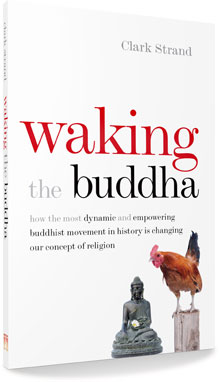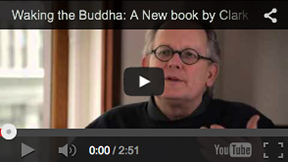 Is there more to Buddhism than sitting in silent meditation? Is modern Buddhism relevant to the problems of daily life? Does it empower individuals to transform their lives?
Is there more to Buddhism than sitting in silent meditation? Is modern Buddhism relevant to the problems of daily life? Does it empower individuals to transform their lives?
Or has Buddhism become too detached, so still and quiet that the Buddha has fallen asleep?
Waking the Buddha tells the story of the Soka Gakkai International, the largest, most dynamic Buddhist movement in the world today—and one that is waking up and shaking up Buddhism so it can truly work in ordinary people’s lives.
Drawing on his long personal experience as a Buddhist teacher, journalist and editor, Clark Strand offers broad insight into how and why the Soka Gakkai, with its commitment to social justice and its egalitarian approach, has become a role model, not only for other schools of Buddhism, but for other religions as well.
Readers will be inspired by the struggles and triumphs of the Soka Gakkai’s three founding presidents—individuals who staked their lives on the teachings of the Lotus Sutra…and on the extraordinary power of those teachings to help people become happy. These three men dared to revolutionize Buddhism by restoring it to its true purpose: to help people transform their lives and the world they live in. The result is a uniquely relevant form of Buddhism—one that “just makes sense” to the modern mind and is ready to meet the challenges of a global age.
Waking the Buddha will appeal to anyone who wants something more out of Buddhism—or any religion—as it explores the foundations of the Soka Gakkai’s practical spiritual path in which people take the principles of Buddhism and put them to work in everyday life.
What makes the Soka Gakkai International unique in modern Buddhism? How could it have grown from a small organization of Buddhist educators into a global movement of over 12 million members in less than a century? What aspects of the Soka Gakkai International’s culture would other religious groups have to adopt or develop on their own if they wanted to move forward as this movement has done?
Through the author’s encounters with early Japanese Soka Gakkai pioneers, individuals who rebuilt their lives from nothing after World War II, and his interviews with the movement’s top leaders today, readers will find answers to these and many other questions in a book that places the Soka Gakkai International at the very leading edge of religion in the 21st century.


 Waking the Buddha on YouTube
Waking the Buddha on YouTube